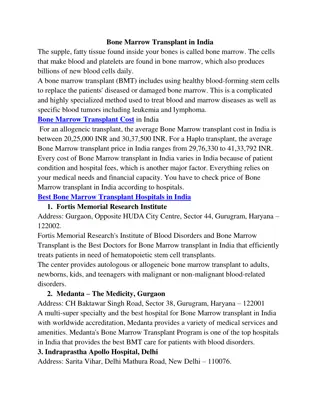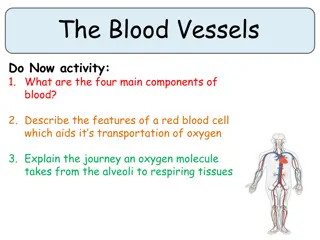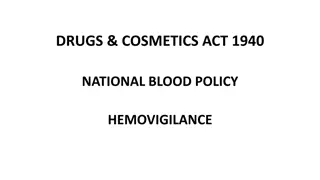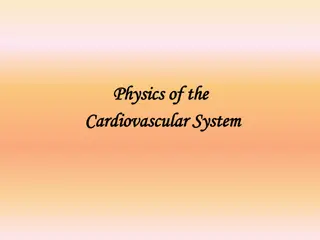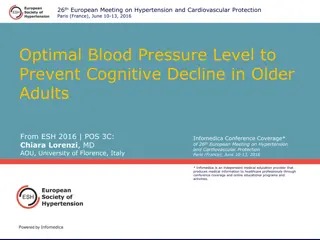Transfusion
Blood transfusion is a crucial medical procedure worldwide, with various components like packed red blood cells, plasma, platelets, and cryoprecipitate being utilized for efficient use. Differential centrifugation is employed for component preparation, ensuring precise separation of red blood cells,
1 views • 45 slides
Differential white blood cell count
Differential white blood cell count, also known as a leukocyte count, is a crucial test to determine the different types of white blood cells present in the blood. The cells are classified into granulocytes (neutrophils, eosinophils, basophils) and agranulocytes (lymphocytes, monocytes). Blood smear
1 views • 21 slides
Understanding Human Blood Groups and Genetics
Human blood groups are determined by the presence or absence of specific antigens and antibodies. The ABO system categorizes blood into four types (A, B, AB, O), while the Rh factor (D antigen) determines whether blood is RhD positive or negative. Blood group antigens are crucial for safe transfusio
2 views • 14 slides
Understanding How Diabetes Affects Blood Vessels
Diabetes can harm blood vessels, leading to complications due to high blood sugar levels. Hemoglobin A1c plays a crucial role in monitoring glucose control, with values above 6.5% indicating diabetes. Over time, high blood sugars can damage blood vessels, affecting blood flow and increasing the risk
1 views • 19 slides
Understanding Red Blood Cell (RBC) Count and Its Significance in Blood Health
Red blood cells, comprising nearly 45% of blood volume, play a crucial role in oxygen transport. The red blood cell count, measured as the number of cells per unit volume of blood, helps assess the adequacy of oxygen-carrying capacity. Normal values vary by age and gender. The experiment aims to det
8 views • 16 slides
Comprehensive ABO Clinical Exam Domains Assessment for School Case
This presentation covers the evaluation of ABO clinical exam domains in a school case scenario, including data gathering, treatment planning, implementation, critical analysis, and outcomes assessment. Various images illustrate the different aspects of the assessment process.
2 views • 14 slides
Understanding Hemoglobin Tests and Hematocrit in Blood Analysis
A hemoglobin test measures the amount of hemoglobin in the blood, which is essential for oxygen transportation in red blood cells. The test is crucial for diagnosing various health conditions, and visual methods are employed for analysis. Additionally, hematocrit, or red blood cell volume, is anothe
9 views • 23 slides
Understanding Patient Blood Management and Guidelines
Patient Blood Management focuses on optimizing a patient's own blood to avoid unnecessary transfusions through three pillars: optimizing tolerance of anemia, blood volume, and minimizing blood loss. Guidelines and recommendations are developed based on systematic reviews of evidence to improve clini
6 views • 18 slides
Understanding the Components of Blood for Better Health
Explore the main components of blood such as red blood cells, white blood cells, platelets, and plasma. Learn how these components function, their percentages in blood, and how they impact human health. Discover the importance of blood donation and how changes in blood composition can affect overall
0 views • 19 slides
Understanding Blood Groups and Their Significance
Human blood types are determined by specific antigens and antibodies present on red blood cells, influencing crucial aspects like blood transfusions and familial relationships in forensic medicine. The ABO system, with its four main blood types (A, B, AB, O), plays a vital role in categorizing blood
5 views • 14 slides
Bone Marrow Transplant Cost in India
The supple, fatty tissue found inside your bones is called bone marrow. The cells that make blood and platelets are found in bone marrow, which also produces billions of new blood cells daily.\nA bone marrow transplant (BMT) includes using healthy blood-forming stem cells to replace the patients' di
1 views • 2 slides
Hypertension (High blood pressure) during Pregnancy Complications and Risks
Hypertension (high blood pressure) occurs when the force of blood flowing through your body is too high. At every appointment during your pregnancy, Your gynecologist will measure your blood pressure. It\u2019s a quick test that can mean a lot to you and your baby\u2019s health. If your blood pressu
1 views • 7 slides
Understanding Blood Transfusion: Components, Preparation, and Safety Measures
Blood transfusion is a crucial medical procedure involving the transfusion of different blood components to patients in need. This practice has evolved to include various components such as packed red blood cells, plasma, platelets, and more. The preparation of these components involves specific tec
1 views • 45 slides
Understanding Blood Cells and Their Functions in the Circulatory System
Blood is comprised of cells and plasma that circulate within the closed circulatory system. The formed elements include erythrocytes, platelets, and leukocytes, each playing vital roles in oxygen transport, defense against infection, and nutrient distribution throughout the body. The hematocrit esti
1 views • 38 slides
Understanding Blood Vessels and Circulation
Explore the components of blood, features of red blood cells, and the journey of oxygen molecules in the circulatory system. Learn about the different types of blood vessels, their structures, functions, and how blood moves through veins. Engage in tasks and self-assessment to enhance your knowledge
1 views • 16 slides
Understanding Blood Groups, Clotting Time, and Bleeding Time in Medical Practice
This informative material delves into the significance of determining blood groups, clotting time, and bleeding time in medical settings. From explaining the ABO and Rhesus systems to outlining the practical objectives and procedures for the assessments, this resource aims to enhance understanding o
0 views • 34 slides
Understanding Differential Leucocyte Count for Blood Disorders
Differential Leucocyte Count (DLC) is crucial for diagnosing blood-related disorders by analyzing the distribution and morphology of white blood cells. Dr. Versha Prasad explains the significance, normal values, and various conditions like neutrophilia, lymphocytosis, monocytosis, and basophilia. Th
1 views • 15 slides
Managing Blood Sugar Levels at Home for Low/No Vision
Explore the importance of monitoring blood glucose levels at home for individuals with low/no vision, learn about talking blood glucose meters, and make continuous glucose monitors accessible. Understand why maintaining blood sugar levels is crucial to prevent complications in diabetes, and get tips
2 views • 25 slides
Understanding Coagulants, Anti-Coagulants, and Blood Components in Pharmaceuticals
Mrs. Sashmitha Samuel, an Associate Professor in the Department of Pharmaceutical Chemistry, delves into the importance of coagulants, anti-coagulants, and the components of blood. Blood, a vital fluid in the body, carries nutrients, oxygen, and helps remove waste products. Learn about the process o
1 views • 43 slides
Understanding Blood Cells and Transport Mechanisms
Your blood, consisting of red blood cells, white blood cells, platelets, and plasma, plays a crucial role in transporting substances like oxygen, nutrients, and waste products throughout your body. Red blood cells are specialized for oxygen transport due to their unique adaptations, while white bloo
2 views • 18 slides
Comprehensive Training for Transporting Blood Products Internally
This training module covers the essential aspects of transporting blood products internally, including who is permitted to handle blood, what responsibilities they have, and how to ensure safe transportation. It outlines the staff members permitted to transport blood products and the specific guidel
1 views • 17 slides
Achieving 100% Voluntary Non-Remunerated Blood Donation in Oman
In the Sultanate of Oman, the Department of Blood Services has successfully moved towards 100% Voluntary Non-Remunerated Blood Donation (VNRBD), focusing on motivating the public to donate blood regularly. This shift has led to a significant increase in blood donations from 2007 to 2011, with a grow
1 views • 26 slides
Biochemistry of Blood Practical Course Overview
This biochemistry of blood practical course involves various experiments focusing on blood components such as plasma, serum, proteins, enzymes, blood groups, hemoglobin, glucose levels, and more. The course outline includes detailed experiments, marking distribution, guidelines for writing scientifi
3 views • 6 slides
Understanding Cutaneous Circulation and Blood Supply in Different Body Regions
Cutaneous circulation plays a vital role in supplying blood to the skin, with variations in apical and non-apical regions of the body. The blood flow is regulated by neural, thermal, and metabolic factors, and controlled by sympathetic fibers. Sympathetic vasoconstriction and vasodilation affect the
0 views • 19 slides
Blood Grouping Techniques: Methods and Advantages
Various blood grouping techniques including slide or tile method and microplate technique are discussed. Advantages of microplate ABO grouping such as cost-effectiveness, automation potential, and reduction in errors are highlighted. The use of different manual methods and newer techniques in blood
0 views • 11 slides
Understanding White Blood Cell Count and Measurement Methods
White blood cell count measures the number of white blood cells in a specific volume of blood, indicating infection or disease progression. The normal range is 5000-11000 cells/cubic mm, varying with age. Methods include manual and electronic counting using specific instruments. Materials like antic
0 views • 14 slides
Overview of Drugs & Cosmetics Act 1940 and Rules 1945 Concerning Blood Control
The Drugs & Cosmetics Act 1940 and Rules 1945 play a crucial role in regulating the import, manufacture, distribution, and sale of drugs and cosmetics, including human blood products. Blood banks are required to adhere to licensing requirements under this act and abide by specified standards. The ru
1 views • 30 slides
Understanding Anemia: Causes, Mechanisms, and Classifications
Anemia is a condition characterized by a deficiency in red blood cells or their oxygen-carrying capacity, impacting physiological needs. Causes include blood loss, decreased production, and destruction of red blood cells. There are various classifications such as acute and chronic blood loss anemia,
0 views • 19 slides
Regulation of Blood Glucose and Its Importance in Maintaining Health
Blood glucose regulation is crucial for energy supply in the body, particularly for brain function. Understanding the balance of glucose entering and leaving the blood through processes like absorption, glycogenolysis, and gluconeogenesis is vital. Hormones like insulin and glucagon play key roles i
0 views • 10 slides
Understanding ABO Blood Grouping and Rh Groups
ABO blood grouping and Rh factor testing are crucial for blood transfusions and forensic medicine. The presence or absence of specific antigens and antibodies in human blood determines blood type. Genetic inheritance from parents establishes blood type, with codominance influencing offspring phenoty
0 views • 13 slides
Why Do We Match Blood for Patients?
Blood matching for patients is crucial to prevent adverse reactions like hemolysis and death. ABO and RhD compatibility testing are fundamental, along with selecting antigen-negative units for patients with clinically significant antibodies. Beyond mandatory requirements, matching can be complex due
0 views • 9 slides
Understanding Rh Immunization and Blood Group Incompatibility
Rh immunization and blood group incompatibility can lead to serious complications in fetuses and newborns. The ABO and Rhesus systems play crucial roles in determining blood group compatibility. Rh-positive red cells of the fetus entering the maternal circulation can trigger immune responses, leadin
0 views • 65 slides
Understanding Packed Cell Volume (PCV) in Blood Analysis
Packed Cell Volume (PCV), also known as hematocrit, is a crucial parameter in blood analysis that indicates the relative proportion of red blood cells to plasma. It is used for detecting anemia, polycythemia, and assessing red cell indices. The Wintrobe method is commonly employed to measure PCV, in
0 views • 9 slides
Enhancing English Classrooms through Flexible Grouping Strategies
Strategies for grouping students in English classrooms are explored, focusing on the benefits of flexible grouping to cater to diverse learner needs. Various grouping methods, such as mixed ability and similar ability groupings, are discussed alongside a lesson example on exploring different aspects
0 views • 32 slides
Themes and Quotes from "Chronicle of a Blood Merchant
Themes in "Chronicle of a Blood Merchant" encompass a wide range, including blood, marriage, family, superstition, health, poverty, and more. The significance of blood is particularly highlighted, with quotes illustrating the rural attitudes towards blood selling. The novel delves into the complex i
0 views • 25 slides
Understanding Blood Components and Their Administration
Effective blood transfusion therapy relies on the availability and proper administration of various blood components. Separating blood components allows for better patient care by matching transfusions to individual needs and avoiding unnecessary components. Different blood products like packed red
1 views • 27 slides
Understanding High Blood Pressure: Causes, Risks, and Management
High blood pressure, or hypertension, is a condition where the blood exerts elevated force against artery walls, leading to increased heart workload and potential damage to arteries. It poses risks for heart disease, stroke, and kidney issues. Pre-hypertension and danger zones indicate different sta
1 views • 15 slides
Venous Blood Collection Methods and Equipment Overview
Venous blood collection techniques, including antecubital fossa and heel sticks, are commonly used for laboratory examinations. Venous blood is preferred for its large volume and ease of recovery. This article also explores the differences between capillary and venous blood samples in terms of compo
0 views • 8 slides
Understanding the Cardiovascular System: A Detailed Overview
The cardiovascular system, comprising the heart, blood vessels, and blood, plays a crucial role in supplying fuel and oxygen to the body's cells while removing waste products. This system functions as a double pump, circulating blood through the pulmonary and systemic circulatory systems. Proper val
0 views • 23 slides
Optimal Blood Pressure Levels to Prevent Cognitive Decline in Older Adults
Observational study at the 26th European Meeting on Hypertension suggests maintaining high-normal levels of systolic blood pressure between 130-145 mmHg may reduce cognitive decline and mortality risk in older adults. The complex relation between blood pressure and cognitive impairment is explored,
0 views • 9 slides










